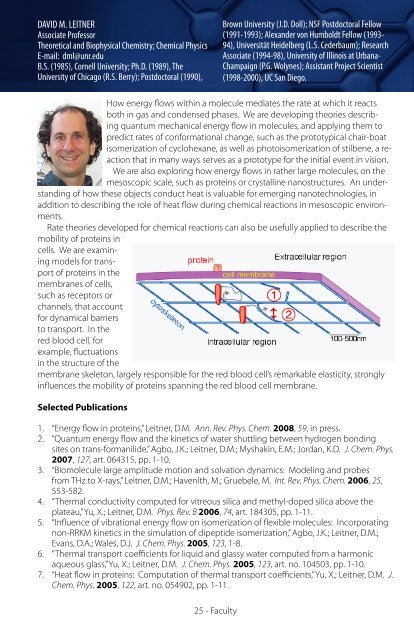Chemistry and Chemical Physics Graduate Programs brochure
Chemistry and Chemical Physics Graduate Programs brochure
Chemistry and Chemical Physics Graduate Programs brochure
Create successful ePaper yourself
Turn your PDF publications into a flip-book with our unique Google optimized e-Paper software.
DAVID M. LEITNER<br />
Associate Professor<br />
Theoretical <strong>and</strong> Biophysical <strong>Chemistry</strong>; <strong>Chemical</strong> <strong>Physics</strong><br />
E-mail: dml@unr.edu<br />
B.S. (1985), Cornell University; Ph.D. (1989), The<br />
University of Chicago (R.S. Berry); Postdoctoral (1990),<br />
25 - Faculty<br />
Brown University (J.D. Doll); NSF Postdoctoral Fellow<br />
(1991-1993); Alex<strong>and</strong>er von Humboldt Fellow (1993-<br />
94), Universität Heidelberg (L.S. Cederbaum); Research<br />
Associate (1994-98), University of Illinois at Urbana-<br />
Champaign (P.G. Wolynes); Assistant Project Scientist<br />
(1998-2000), UC San Diego.<br />
How energy flows within a molecule mediates the rate at which it reacts<br />
both in gas <strong>and</strong> condensed phases. We are developing theories describing<br />
quantum mechanical energy flow in molecules, <strong>and</strong> applying them to<br />
predict rates of conformational change, such as the prototypical chair-boat<br />
isomerization of cyclohexane, as well as photoisomerization of stilbene, a reaction<br />
that in many ways serves as a prototype for the initial event in vision.<br />
We are also exploring how energy flows in rather large molecules, on the<br />
mesoscopic scale, such as proteins or crystalline nanostructures. An underst<strong>and</strong>ing<br />
of how these objects conduct heat is valuable for emerging nanotechnologies, in<br />
addition to describing the role of heat flow during chemical reactions in mesoscopic environments.<br />
Rate theories developed for chemical reactions can also be usefully applied to describe the<br />
mobility of proteins in<br />
cells. We are examining<br />
models for transport<br />
of proteins in the<br />
membranes of cells,<br />
such as receptors or<br />
channels, that account<br />
for dynamical barriers<br />
to transport. In the<br />
red blood cell, for<br />
example, fluctuations<br />
in the structure of the<br />
membrane skeleton, largely responsible for the red blood cell’s remarkable elasticity, strongly<br />
influences the mobility of proteins spanning the red blood cell membrane.<br />
Selected Publications<br />
1. “Energy flow in proteins,” Leitner, D.M. Ann. Rev. Phys. Chem. 2008, 59, in press.<br />
2. “Quantum energy flow <strong>and</strong> the kinetics of water shuttling between hydrogen bonding<br />
sites on trans-formanilide,” Agbo, J.K.; Leitner, D.M.; Myshakin, E.M.; Jordan, K.D. J. Chem. Phys.<br />
2007, 127, art. 064315, pp. 1-10.<br />
3. “Biomolecule large amplitude motion <strong>and</strong> solvation dynamics: Modeling <strong>and</strong> probes<br />
from THz to X-rays,” Leitner, D.M.; Havenith, M.; Gruebele, M. Int. Rev. Phys. Chem. 2006, 25,<br />
553-582.<br />
4. “Thermal conductivity computed for vitreous silica <strong>and</strong> methyl-doped silica above the<br />
plateau,” Yu, X.; Leitner, D.M. Phys. Rev. B 2006, 74, art. 184305, pp. 1-11.<br />
5. “Influence of vibrational energy flow on isomerization of flexible molecules: Incorporating<br />
non-RRKM kinetics in the simulation of dipeptide isomerization,” Agbo, J.K.; Leitner, D.M.;<br />
Evans, D.A.; Wales, D.J. J. Chem. Phys. 2005, 123, 1-8.<br />
6. “Thermal transport coefficients for liquid <strong>and</strong> glassy water computed from a harmonic<br />
aqueous glass,” Yu, X.; Leitner, D.M. J. Chem. Phys. 2005, 123, art. no. 104503, pp. 1-10.<br />
7. “Heat flow in proteins: Computation of thermal transport coefficients,” Yu, X.; Leitner, D.M. J.<br />
Chem. Phys. 2005, 122, art. no. 054902, pp. 1-11.


